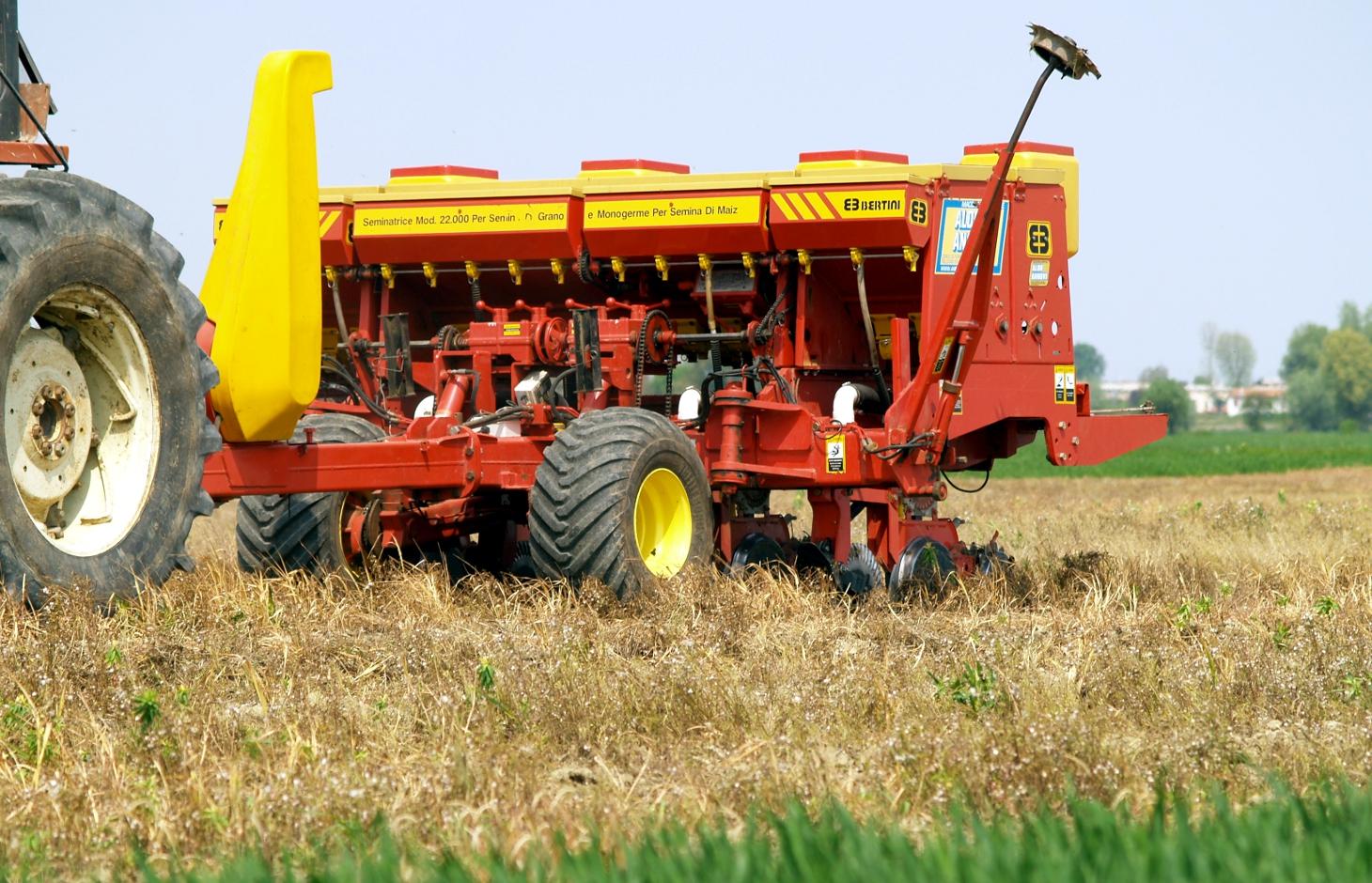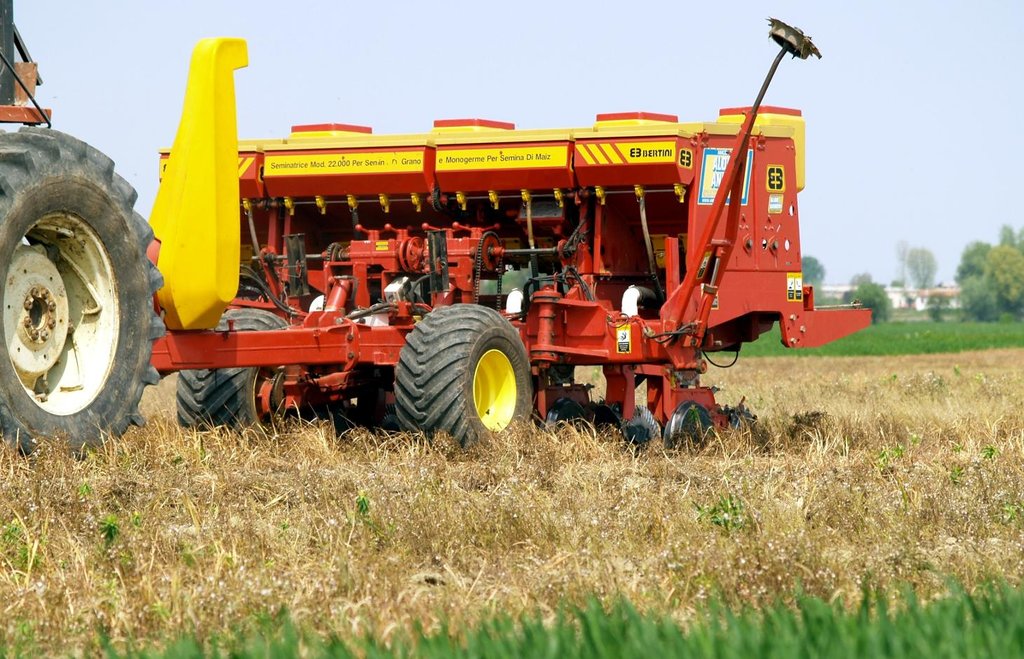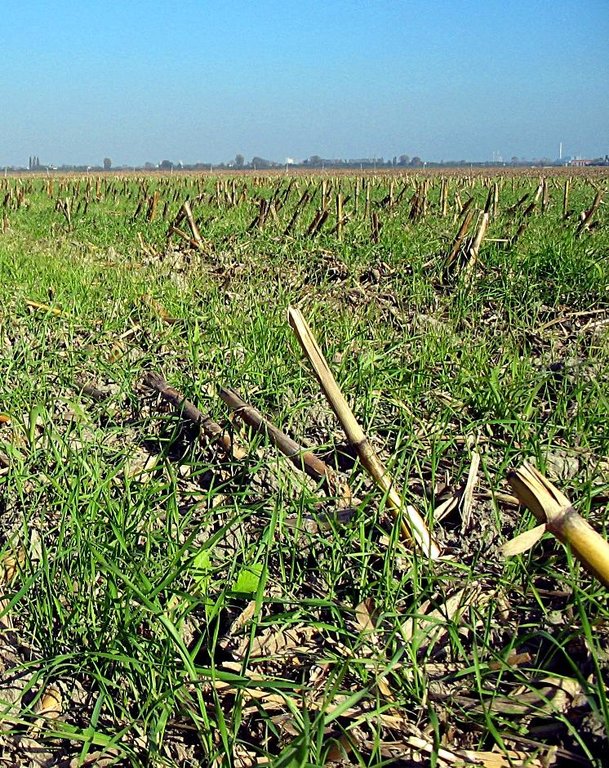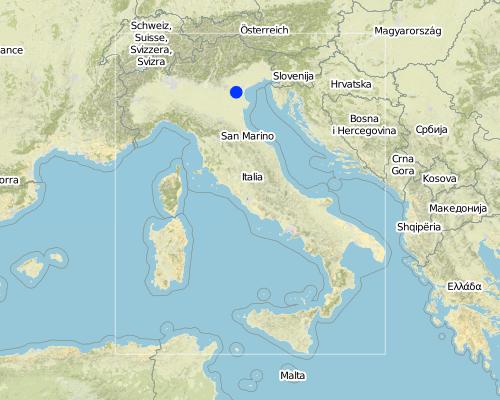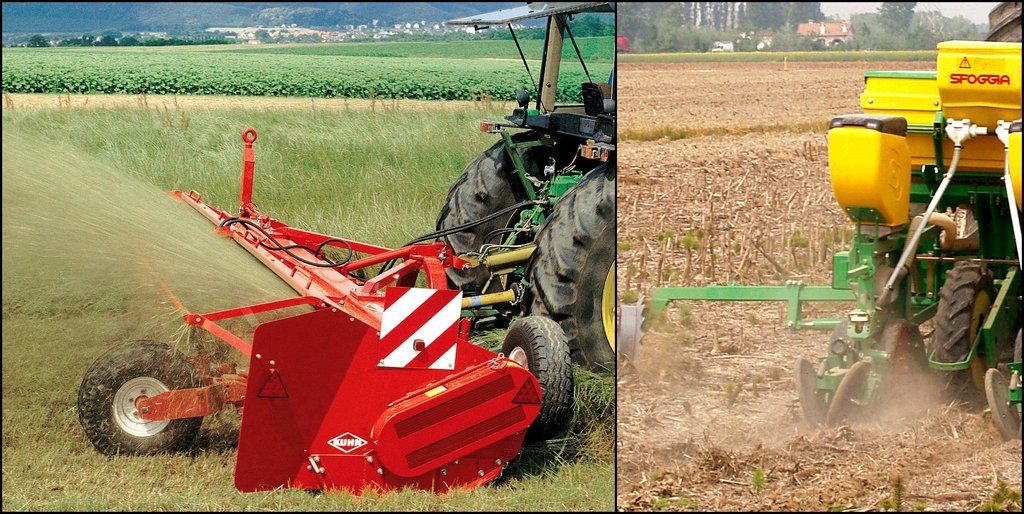Conservation agriculture [Italie]
- Création :
- Mise à jour :
- Compilateur : Nicola Dal Ferro
- Rédacteur : –
- Examinateur : Fabian Ottiger
Agricoltura conservativa
technologies_1225 - Italie
Voir les sections
Développer tout Réduire tout1. Informations générales
1.2 Coordonnées des personnes-ressources et des institutions impliquées dans l'évaluation et la documentation de la Technologie
Spécialiste GDT:
Morari Francesco
francesco.morari@unipd.it
University of Padova
Via 8 Febbraio 1848, 2, 35122 Padova PD, Italy
Italie
Nom du projet qui a facilité la documentation/ l'évaluation de la Technologie (si pertinent)
Preventing and Remediating degradation of soils in Europe through Land Care (EU-RECARE )Nom du ou des institutions qui ont facilité la documentation/ l'évaluation de la Technologie (si pertinent)
University of Padova (UNIPD) - Italie1.3 Conditions relatives à l'utilisation par WOCAT des données documentées
Quand les données ont-elles été compilées (sur le terrain)?
20/10/2014
Le compilateur et la(les) personne(s) ressource(s) acceptent les conditions relatives à l'utilisation par WOCAT des données documentées:
Oui
1.5 Référence au(x) questionnaire(s) sur les Approches de GDT
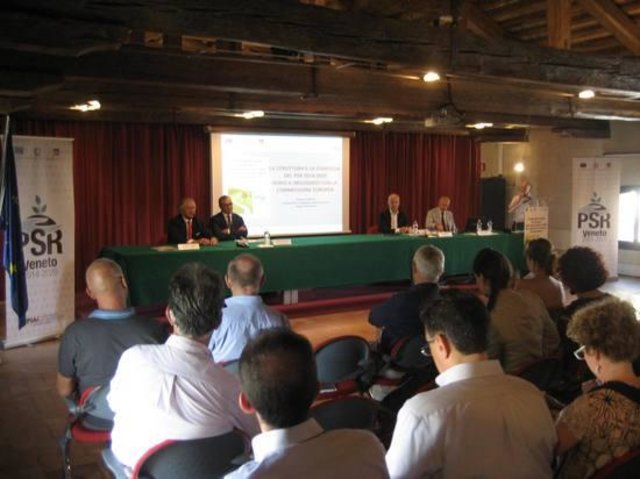
Rural development programme in the Veneto region [Italie]
Developing rural areas in the Veneto region through sustainable land management policies
- Compilateur : Nicola Dal Ferro
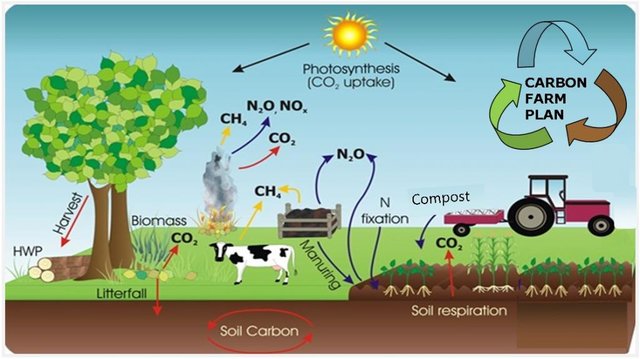
Carbon farming [Italie]
Managing land, water, plants and animals to meet the landscape restoration, climate change and food security.
- Compilateur : Nicola Dal Ferro
2. Description de la Technologie de GDT
2.1 Courte description de la Technologie
Définition de la Technologie:
Sustainable crop production and residue management under no-tillage to improve soil fertility and increase environmental benefits
2.2 Description détaillée de la Technologie
Description:
Conservation agriculture (CA) in the Veneto region is characterised by management systems including no-tillage, permanent soil cover and crop rotation. CA has been promoted as an agri-environmental measure of the Rural Development Programme (RDP) by the Veneto region to extend sustainable land management. In spite of being provided by the regional government with subsidies, so far the adoption of CA by the farmers has been very limited since its introduction, amounting less than 1% (ca. 2000 ha) of the total regional cropland area (mainly concentrated in the low Venetian plain).
Purpose of the Technology: CA has been proposed to the farmers with the aim of reducing environmental impacts as well as economic and energetic inputs to the agricultural system. Compared with conventional practices such as soil ploughing, CA is convenient due to the saving of labour and fuel costs, with a direct effect in reducing CO2 emissions into the atmosphere. Limiting the soil disturbance and guaranteeing the continuous soil cover involve both a reduction of water runoff and surface erosion and an increase of soil biodiversity and fertility.
Establishment / maintenance activities and inputs: The main winter crops usually cultivated in the low Venetian plain are wheat, rapeseed and barley, while summer season crops are maize, soybean, sorghum. Generally CA consists of direct sowing on untilled soil using a double-disk opener planter for seed deposition, while after harvesting crop residues are chopped and dispersed to the surface in order to guarantee a mulching effect and a rapid incorporation into the soil. Since application of CA practices consider the permanent soil cover, the main crop is followed by cover crops that are usually graminaceae or brassicaceae. Cover crops are neither fertilized nor treated with pesticides during growing, while their final devitalisation is achieved with non-specific herbicides (e.g. Glyphosate, Glufosinate Ammonium).
Natural / human environment: Advantages of adopting conservation agriculture have been widely demonstrated worldwide and can be classified in economic, agronomic and environmental benefits. From an environmental point of view, the soil system preserves its structure and biodiversity thanks to minimum soil disturbance to the root zone, microorganisms, fungi and macroinvertebrates. Greenhouse gas emissions under conservation agriculture compared to traditional cultivation systems are lower and might offset the gains obtained to mitigate global warming. Due to the recent introduction of the technology in the Veneto region (since mid-2000s), conservation agriculture has shown contrasting results in terms of crop yield since still in a transition period between conventional and conservation agriculture practices.
2.3 Photos de la Technologie
2.5 Pays/ région/ lieux où la Technologie a été appliquée et qui sont couverts par cette évaluation
Pays:
Italie
Région/ Etat/ Province:
Italy
Autres spécifications du lieu:
Low Venetian plain of Veneto region
Map
×2.6 Date de mise en œuvre de la Technologie
Si l'année précise est inconnue, indiquez la date approximative: :
- il y a entre 10-50 ans
2.7 Introduction de la Technologie
Spécifiez comment la Technologie a été introduite: :
- au cours d'expérimentations / de recherches
3. Classification de la Technologie de GDT
3.1 Principal(aux) objectif(s) de la Technologie
- réduire, prévenir, restaurer les terres dégradées
3.2 Type(s) actuel(s) d'utilisation des terres, là où la Technologie est appliquée

Terres cultivées
- Cultures annuelles
Principales cultures (vivrières et commerciales):
Major cash crop: Maize
Other crops: Wheat, soybean
Commentaires:
Major land use problems (compiler’s opinion): Soils in the low Venetian plain of the Veneto region generally suffer from a loss of soil organic matter (SOM) that is strongly affected by their natural texture and climatic conditions. Moreover, in the last 50 years intensive tillage practices contributed to a further SOM decrease, estimated at 0.02-0.58 t/ha/y of carbon.
Major land use problems (land users’ perception): Decrease of productivity, soil compaction. To date, few farmers have adopted voluntarily conservation practices to reduce a decline of soil fertility and SOM content, symptom of poor perception of the problem. Moreover, the low technical know-how causes low yield performances and discouraged farmers to adopt the SLM technology.
3.3 Informations complémentaires sur l'utilisation des terres
Approvisionnement en eau des terres sur lesquelles est appliquée la Technologie:
- mixte: pluvial-irrigué
Commentaires:
Water supply: Also rainfed, full irrigation
Nombre de période de croissance par an: :
- 1
Précisez:
Longest growing period in days: 210 Longest growing period from month to month: March to OctoberSecond longest growing period in days: 180Second longest growing period from month to month: April to September
3.4 Groupe de GDT auquel appartient la Technologie
- Amélioration de la couverture végétale/ du sol
- perturbation minimale du sol
3.5 Diffusion de la Technologie
Spécifiez la diffusion de la Technologie:
- répartie uniformément sur une zone
Si la Technologie est uniformément répartie sur une zone, indiquez la superficie couverte approximative:
- 10-100 km2
3.6 Mesures de GDT constituant la Technologie

pratiques agronomiques
- A1: Couverture végétale/ du sol
- A3: Traitement de la couche superficielle du sol

modes de gestion
- M2: Changement du niveau de gestion / d'intensification
Commentaires:
Main measures: agronomic measures
Secondary measures: management measures
Type of agronomic measures: cover cropping, mulching, zero tillage / no-till
3.7 Principaux types de dégradation des terres traités par la Technologie

dégradation chimique des sols
- Cn: baisse de la fertilité des sols et réduction du niveau de matière organique (non causée par l’érosion)

dégradation biologique
- Bc: réduction de la couverture végétale
- Bl: perte de la vie des sols
Commentaires:
Main type of degradation addressed: Cn: fertility decline and reduced organic matter content, Bc: reduction of vegetation cover, Bl: loss of soil life
Main causes of degradation: soil management (lack of organic input with fertilizations), population pressure (High demand for agricultural products and competition for land in densely populated area)
Secondary causes of degradation: crop management (annual, perennial, tree/shrub) (crop monoculture instead of crop rotation)
3.8 Prévention, réduction de la dégradation ou réhabilitation des terres dégradées
Spécifiez l'objectif de la Technologie au regard de la dégradation des terres:
- prévenir la dégradation des terres
- réduire la dégradation des terres
Commentaires:
Main goals: prevention of land degradation
Secondary goals: mitigation / reduction of land degradation
4. Spécifications techniques, activités, intrants et coûts de mise en œuvre
4.1 Dessin technique de la Technologie
4.2 Spécification/ explications techniques du dessin technique
Detailed view of direct sowing on untilled soil and chopping of crop residues
Location: Low Venetian plain of Veneto region
Technical knowledge required for field staff / advisors: high
Technical knowledge required for land users: moderate
Main technical functions: control of raindrop splash, control of dispersed runoff: impede / retard, improvement of ground cover, improvement of topsoil structure (compaction), increase in organic matter
Secondary technical functions: control of concentrated runoff: impede / retard, increase of surface roughness, increase of infiltration, increase / maintain water stored in soil
Cover cropping
Material/ species: e.g. barley and vetch, lolium, sorghum
Mulching
Material/ species: Residues depending on the main crop
Change of land use practices / intensity level: With conservation agriculture labour is saved and fuel cost lowered. Additional application of pesticides represents an extra expenditure.
4.3 Informations générales sur le calcul des intrants et des coûts
autre/ monnaie nationale (précisez):
Euro €
Indiquer le taux de change du dollars en monnaie locale (si pertinent): 1 USD= :
0,8
Indiquez le coût salarial moyen de la main d'œuvre par jour:
110.00
4.6 Activités d'entretien/ récurrentes
| Activité | Type de mesures | Calendrier/ fréquence | |
|---|---|---|---|
| 1. | Weed control and cover crops devitalisation | Agronomique | each crop season |
| 2. | Main crop: direct sowing on untilled soil | Agronomique | each crop season |
| 3. | Main crop: fertilisation | Agronomique | each crop season |
| 4. | Main crop: combined harvesting and chopping of straw | Agronomique | each crop season |
| 5. | Cover crops: sowing | Agronomique | each crop season |
4.7 Coûts et intrants nécessaires aux activités d'entretien/ récurrentes (par an)
| Spécifiez les intrants | Unité | Quantité | Coûts par unité | Coût total par intrant | % des coût supporté par les exploitants des terres | |
|---|---|---|---|---|---|---|
| Main d'œuvre | Weed control and cover crops devitalisation | L/ha | 1,0 | 130,0 | 130,0 | |
| Main d'œuvre | Cover crops: sowing | ha | 1,0 | 254,0 | 254,0 | |
| Equipements | Weed control and cover crops devitalisation | ha | 1,0 | 44,5 | 44,5 | |
| Equipements | Main crop: direct sowing on untilled soil | ha | 1,0 | 63,5 | 63,5 | |
| Equipements | Main crop: combined harvesting and chopping of straw | ha | 1,0 | 190,5 | 190,5 | |
| Matériel végétal | Seeds | ha | 1,0 | 190,5 | 190,5 | |
| Engrais et biocides | Fertilisation | ha | 1,0 | 287,0 | 287,0 | |
| Coût total d'entretien de la Technologie | 1160,0 | |||||
4.8 Facteurs les plus importants affectant les coûts
Décrivez les facteurs les plus importants affectant les coûts :
Costs are mostly affected by field labours, although they are considerably lower than under conventional tillage practices. They do not include initial investments since usually farmers to rely on agricultural contractors. As a result, intial investements are borne by agricultural contractors (e.g. sod seeding machinery, which costs 35000$, on average).
5. Environnement naturel et humain
5.1 Climat
Précipitations annuelles
- < 250 mm
- 251-500 mm
- 501-750 mm
- 751-1000 mm
- 1001-1500 mm
- 1501-2000 mm
- 2001-3000 mm
- 3001-4000 mm
- > 4000 mm
Spécifiez la pluviométrie moyenne annuelle (si connue), en mm:
850,00
Spécifications/ commentaires sur les précipitations:
Max in June (100 mm) and minima in winter (55 mm, December to February)
Zone agro-climatique
- subhumide
Thermal climate class: temperate (the low Venetian plain where the technology is applied has continental climate)
5.2 Topographie
Pentes moyennes:
- plat (0-2 %)
- faible (3-5%)
- modéré (6-10%)
- onduleux (11-15%)
- vallonné (16-30%)
- raide (31-60%)
- très raide (>60%)
Reliefs:
- plateaux/ plaines
- crêtes
- flancs/ pentes de montagne
- flancs/ pentes de colline
- piémonts/ glacis (bas de pente)
- fonds de vallée/bas-fonds
Zones altitudinales:
- 0-100 m
- 101-500 m
- 501-1000 m
- 1001-1500 m
- 1501-2000 m
- 2001-2500 m
- 2501-3000 m
- 3001-4000 m
- > 4000 m
Commentaires et précisions supplémentaires sur la topographie:
Altitudinal zone: 0-100 m a.s.l. (the low Venetian does not exceed 50 m above sea level)
5.3 Sols
Profondeur moyenne du sol:
- très superficiel (0-20 cm)
- superficiel (21-50 cm)
- modérément profond (51-80 cm)
- profond (81-120 cm)
- très profond (>120 cm)
Texture du sol (de la couche arable):
- grossier/ léger (sablonneux)
- moyen (limoneux)
Matière organique de la couche arable:
- moyen (1-3%)
- faible (<1%)
Si disponible, joignez une description complète du sol ou précisez les informations disponibles, par ex., type de sol, pH/ acidité du sol, capacité d'échange cationique, azote, salinité, etc.
Soil fertility is low-medium
Soil drainage/infiltration is medium
Soil water storage capacity is medium
5.4 Disponibilité et qualité de l'eau
Profondeur estimée de l’eau dans le sol:
< 5 m
Disponibilité de l’eau de surface:
bonne
Qualité de l’eau (non traitée):
eau potable
Commentaires et précisions supplémentaires sur la qualité et la quantité d'eau:
Ground water table: <5m (The area surrounding the Venice lagoon (1240 km2) is even below the sea level (down to -2 m) and currently cultivated due to land reclamation. As a result water table is kept artificially low)
Water quality (untreated) is good drinking water (groundwater) or for agricultural use only (irrigation: Surface water can be used for agricultural purposes but not as drinking water)
5.5 Biodiversité
Diversité des espèces:
- moyenne
Commentaires et précisions supplémentaires sur la biodiversité:
High population density, infrastructures and intensive agriculture practices affect the state of biodiversity.
5.6 Caractéristiques des exploitants des terres appliquant la Technologie
Orientation du système de production:
- commercial/ de marché
Revenus hors exploitation:
- moins de 10% de tous les revenus
Niveau relatif de richesse:
- moyen
- riche
Individus ou groupes:
- individu/ ménage
Niveau de mécanisation:
- mécanisé/ motorisé
Genre:
- hommes
Indiquez toute autre caractéristique pertinente des exploitants des terres:
Land users applying the Technology are mainly common / average land users
Difference in the involvement of women and men: Farmers in the Veneto region are traditionally males due to historical and cultural reasons.
Population density: 200-500 persons/km2
Annual population growth: 0.5% - 1%
Off-farm income specification: The conservation measure is applied by farmers whose main income is from agriculture activity.
5.7 Superficie moyenne des terres détenues ou louées par les exploitants appliquant la Technologie
- < 0,5 ha
- 0,5-1 ha
- 1-2 ha
- 2-5 ha
- 5-15 ha
- 15-50 ha
- 50-100 ha
- 100-500 ha
- 500-1 000 ha
- 1 000-10 000 ha
- > 10 000 ha
Cette superficie est-elle considérée comme de petite, moyenne ou grande dimension (en se référant au contexte local)?
- grande dimension
5.8 Propriété foncière, droits d’utilisation des terres et de l'eau
Propriété foncière:
- individu, sans titre de propriété
Droits d’utilisation des terres:
- loué
- individuel
Droits d’utilisation de l’eau:
- communautaire (organisé)
- loué
5.9 Accès aux services et aux infrastructures
santé:
- pauvre
- modéré
- bonne
éducation:
- pauvre
- modéré
- bonne
assistance technique:
- pauvre
- modéré
- bonne
emploi (par ex. hors exploitation):
- pauvre
- modéré
- bonne
marchés:
- pauvre
- modéré
- bonne
énergie:
- pauvre
- modéré
- bonne
routes et transports:
- pauvre
- modéré
- bonne
eau potable et assainissement:
- pauvre
- modéré
- bonne
services financiers:
- pauvre
- modéré
- bonne
6. Impacts et conclusions
6.1 Impacts sur site que la Technologie a montrés
Impacts socio-économiques
Production
production agricole
Commentaires/ spécifiez:
In the early years
Revenus et coûts
dépenses pour les intrants agricoles
charge de travail
Impacts socioculturels
connaissances sur la GDT/ dégradation des terres
Improved livelihoods and human well-being
Impacts écologiques
Cycle de l'eau/ ruissellement
ruissellement de surface
drainage de l'excès d'eau
évaporation
Sols
couverture du sol
perte en sol
encroûtement/ battance du sol
compaction du sol
Biodiversité: végétale, animale
diversité des habitats
contrôle des animaux nuisibles/ maladies
Commentaires/ spécifiez:
Increased reliance on herbicides
6.3 Exposition et sensibilité de la Technologie aux changements progressifs et aux évènements extrêmes/catastrophes liés au climat (telles que perçues par les exploitants des terres)
Changements climatiques progressifs
Changements climatiques progressifs
| Saison | Type de changements/ extrêmes climatiques | Comment la Technologie fait-elle face à cela? | |
|---|---|---|---|
| températures annuelles | augmente | bien |
Extrêmes climatiques (catastrophes)
Catastrophes météorologiques
| Comment la Technologie fait-elle face à cela? | |
|---|---|
| pluie torrentielle locale | bien |
Autres conséquences liées au climat
Autres conséquences liées au climat
| Comment la Technologie fait-elle face à cela? | |
|---|---|
| réduction de la période de croissance | bien |
6.4 Analyse coûts-bénéfices
Quels sont les bénéfices comparativement aux coûts de mise en place (du point de vue des exploitants des terres)?
Rentabilité à court terme:
négative
Rentabilité à long terme:
légèrement positive
Quels sont les bénéfices comparativement aux coûts d'entretien récurrents (du point de vue des exploitants des terres)?
Rentabilité à court terme:
neutre / équilibrée
Rentabilité à long terme:
positive
6.5 Adoption de la Technologie
Commentaires:
100% of land user families have adopted the Technology with external material support
There is a little trend towards spontaneous adoption of the Technology
6.7 Points forts/ avantages/ possibilités de la Technologie
| Points forts/ avantages/ possibilités du point de vue du compilateur ou d'une autre personne ressource clé |
|---|
|
Lowers soil tillage costs due to a reduction of fuel consumption and labour How can they be sustained / enhanced? Spread over greater areas to maximise cost reduction |
|
Lowers CO2 emissions due to a general reduction of energy inputs How can they be sustained / enhanced? Identification of CA as an agricultural practice to mitigate global warming. Spread over greater areas to increase effectiveness |
|
Reduces water runoff and erosion while increasing soil coverage and biodiversity How can they be sustained / enhanced? Further improvement of soil quality might consider organic fertilizations |
|
Enhances in general the sustainability of cropping systems How can they be sustained / enhanced? Maintain conservation agriculture system in the long-term to maximise benefits |
6.8 Faiblesses/ inconvénients/ risques de la Technologie et moyens de les surmonter
| Faiblesses/ inconvénients/ risques du point de vue du compilateur ou d'une autre personne ressource clé | Comment peuvent-ils être surmontés? |
|---|---|
| Soil compaction is sometimes emerging | Periodic decompaction and adoption of lighter machinery |
| Crop productions are sometimes lower than with conventional practices | Stabilize conservation agriculture in the long-term. Support farmers in technical choices |
7. Références et liens
7.2 Références des publications disponibles
Titre, auteur, année, ISBN:
Programma di sviluppo rurale per il veneto 2007-2013, Regione Veneto, 2007. Dipartimento Agricoltura e Sviluppo Rurale.
Liens et modules
Développer tout Réduire toutLiens

Rural development programme in the Veneto region [Italie]
Developing rural areas in the Veneto region through sustainable land management policies
- Compilateur : Nicola Dal Ferro

Carbon farming [Italie]
Managing land, water, plants and animals to meet the landscape restoration, climate change and food security.
- Compilateur : Nicola Dal Ferro
Modules
Aucun module trouvé


